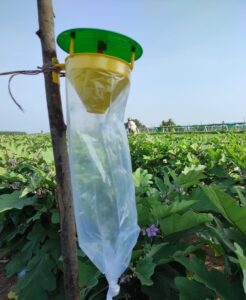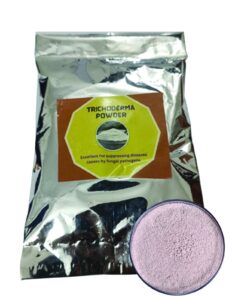Plant Protection Material (PPM)
Pheromone traps are an important tool in pest management that use synthetic versions of natural insect pheromones to lure and capture pests. These traps are primarily used to monitor and control pest populations in an eco-friendly way, reducing the reliance on chemical pesticides. Pheromones are chemical signals released by insects, particularly females, to attract mates. By mimicking these natural pheromones, pheromone traps specifically attract male insects, interfering with their mating process and thus reducing the pest population over time.
There are different types of pheromone traps, including sticky traps, funnel traps, and Fruit Fly traps. The choice of trap depends on the specific pest being targeted. For example, sticky traps are coated with an adhesive that captures the insect upon contact, while bucket traps often use water or oil to trap and drown the insects.
The benefits of pheromone traps include being selective (targeting only specific pests), eco-friendly, and cost-effective. Unlike chemical pesticides, pheromone traps do not harm beneficial insects such as pollinators, and they help reduce environmental contamination.
Pheromone traps come in various types, each designed to target specific pests and optimize pest management strategies. Commonly used pheromone traps:
1. Sticky Traps
- These traps have a sticky surface that captures insects when they land on it after being attracted by the pheromone.
- Use: Commonly used for monitoring pest populations and capturing flying insects. They are easy to deploy and inspect.
Yellow sticky traps are an effective pest management tool used to monitor and control flying insects. Their bright yellow color attracts pests like aphids, thrips, and whiteflies, while the adhesive surface captures them upon contact. These traps are cost-effective, non-toxic, and easy to deploy, making them suitable for both small and large-scale growers. Placed at plant height in greenhouses or fields, they provide valuable insights into pest populations. Regular monitoring and replacement are essential for maintaining their effectiveness, contributing to Integrated Pest Management (IPM) strategies by reducing reliance on chemical insecticides.

Blue sticky traps are effective tools for monitoring and controlling specific pests, particularly those that are attracted to blue wavelengths, such as thrips and certain types of beetles. Like yellow sticky traps, they feature an adhesive surface that captures insects upon contact. Their blue color enhances visibility, making it easy to assess pest populations. These traps are cost-effective, non-toxic, and simple to use, suitable for both commercial and home gardens. Placed strategically at plant height, blue sticky traps provide valuable data for pest management decisions and help reduce reliance on chemical pesticides in Integrated Pest Management (IPM) programs.

2. Funnel Traps
- Funnel-shaped traps allow insects to enter through the top but make it difficult for them to escape once inside.
- Use: Effective for capturing various insect species, including moths and beetles. They often contain a collection container for easy disposal.
Funnel traps are designed to capture insects by utilizing a funnel-shaped entrance that allows them to enter but prevents escape. Commonly used in pest monitoring, these traps are effective for targeting various flying insects, including moths and beetles. Typically made from plastic or metal, funnel traps often include a collection container at the bottom to hold captured insects. They can be baited with pheromones or other attractants to enhance effectiveness. Easy to deploy and maintain, funnel traps are valuable tools in Integrated Pest Management (IPM), providing critical data on pest populations while minimizing chemical pesticide use.

3. Fruit Fly Lure Traps
- These traps incorporate a lure dispenser that releases pheromones over time, attracting pests from a distance.
- Use: Suitable for long-term monitoring and can cover larger areas compared to other trap types.
Fruit fly traps are specialized devices designed to attract and capture fruit flies, particularly species like the Mediterranean fruit fly and the vinegar fly. These traps typically use a combination of bait—such as fruit juice, vinegar, or commercial attractants—and a trapping mechanism, which may be sticky or liquid-based. The traps lure fruit flies in with enticing scents, where they become trapped and unable to escape. Easy to set up and monitor, fruit fly traps play a crucial role in pest management for orchards and gardens, helping to prevent infestations and reduce reliance on chemical pesticides in Integrated Pest Management (IPM) practices.

Each type of pheromone trap serves a unique purpose in pest management, and the choice depends on the specific pest being targeted, the environment, and the goals of the pest control strategy.
Neem Oil
Neem oil is a natural pesticide derived from the seeds of the neem tree (Azadirachta indica). It contains active compounds like azadirachtin, which disrupt insect growth and reproduction, making it effective against a wide range of pests, including aphids, whiteflies, and spider mites. Neem oil acts as both a repellent and a growth regulator, helping to manage pest populations while being safe for beneficial insects when used correctly. Additionally, it has antifungal properties, making it useful in preventing plant diseases. As a biodegradable and eco-friendly option, neem oil is widely used in organic gardening and Integrated Pest Management (IPM) strategies.

Trichoderma
Trichoderma is a genus of beneficial fungi widely recognized for its role in agricultural pest and disease management. It acts as a biological control agent, suppressing soil-borne pathogens like Fusarium and Rhizoctonia. Trichoderma enhances plant health by promoting root growth, improving nutrient uptake, and increasing resistance to environmental stress. It can be applied as a soil amendment or as a seed treatment, helping to boost crop yields sustainably. Additionally, Trichoderma is known for its ability to decompose organic matter, enriching the soil microbiome. Its use in Integrated Pest Management (IPM) supports environmentally friendly agricultural practices, reducing reliance on chemical fungicides.
